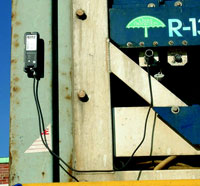World Cargo News – February 2008 - “Mark-It
Goes Wireless”

Leading US reefer monitoring service provider Mark-It Services (MIS)
has launched a wireless asset monitoring (WAM) solution for reefer
containers called WAM-D. MIS has been providing reefer monitoring
services in the US since 1989 and serves all major shipping lines
and intermodal providers there, monitoring over 75,000 containers
per month.
The new WAM-D solution enables wireless monitoring and control through
a hardware and software platform that is available to reefer owners
through MISís core service offerings and to ports and intermodal
terminals as a standalone system. It is based around a proprietary
data acquisition device, effectively an active RFID tag with a full
two-way radio, that is connected to the reefer unit data port. The
unit is powered by a replaceable longlife battery so it can operate
independently of the reefer container itself. The tags are read
in the yard by a single reader node that can pick up tags in a 200-400m
radius. Data is then sent from the reader node to a server in the
control room.
With WAM-D terminals, reefer service providers can monitor information
such as container number, setpoint and status and perform pre-trip
inspections (PTIs) remotely. A big advantage of the system is that
marine terminals can purchase the hardware and the licence for the
software from MIS without the actual container owner needing to
be involved. By attaching the WAM-D devices while containers are
in the terminal, port operators can take greater control of the
reefer monitoring process and automate many existing manual procedures.
With the WAM-D software, terminals can see the full range of monitoring
information, including status and alerts, displayed graphically
and generate reports to meet information requirements. They can
also download a container’s full data record for future reference
should any issue of liability arise.
Through integration with the core TOS application the container
ID can be linked to position information to enable any problem containers
to be quickly identified on the terminal. Alarms can be generated
when containers enter the terminal and are not fitted with a WAM-D
device within a certain timeframe or when a container is disconnected
from a WAM-D without being gated-out by the TOS.
MIS is also marketing the system to reefer owners, who can improve
their whole asset management system by attaching the WAM-D devices
to reefers permanently. Real time status information can be integrated
into existing management applications and notification systems to
improve the asset cycle and protection for refrigerated cargo. Significant
time can be saved by performing procedures such as PTIs across all
the containers in a reefer stack simultaneously.
The system infrastructure is designed to keep the set up cost low
and to allow a terminal operator to implement WAM-D without needing
to involve the existing wireless LAN provider. The cost of each
WAM-D device itself is comparable to an active RFID tag and the
reader node costs less than a typical 802.11 access point. To carry
data back to the control room, MIS installs a point-to-point WiFi
with a range of up to three miles. Terminals could use an existing
802.11 network, but MIS has found most customers prefer a separate
link to avoid overloading or coverage issues as well as needing
to involve the original wireless provider.
As a “localised” asset management system, WAM-D does
not require the user to subscribe to any public communication or
satellite networks and pay the associated user fees. For customers
who require global monitoring integrated with tracking, MIS is developing
a variant with GPRS.



